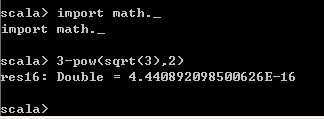标签:blog http io ar os 使用 java for sp
近期对Scala比较感兴趣,买了本《快学Scala》,感觉不错。比《Programming Scala:Tackle Multi-Core Complexity on the Java Virtual Machine》好很多。 是本不错的入门书。而且每个章节都设置了难度级别,每章有习题,可以巩固Scala语法。
本文的目的就是针对这些习题进行解答
这个。。。。直接操作一遍就有结果了.此题不知是翻译的问题,还是原题的问题,在Scala REPL中需要按3. 然后按Tab才会提示。 直接按3加Tab是没有提示的。下面是结果
!= ## % & * + - / < << <= == > >= >> >>> ^ asInstanceOf equals getClass hashCode isInstanceOf toByte toChar toDouble toFloat toInt toLong toShort toString unary_+ unary_- unary_~ |
列出的方法并不全,需要查询全部方法还是需要到Scaladoc中的Int,Double,RichInt,RichDouble等类中去查看。
依次进行计算即可
scala> scala.math.sqrt(3) warning: there were 1 deprecation warnings; re-run with -deprecation for details res5: Double = 1.7320508075688772 scala> res5*res5 res6: Double = 2.9999999999999996 scala> 3 - res6 res7: Double = 4.440892098500626E-16
或

2.3 res变量是val还是var?
val是不可变的,而var是可变的,只需要给res变量重新赋值就可以检测res是val还是var了
scala> res9 = 3
<console>:8: error: reassignment to val
res9 = 3
^
2.4 Scala允许你用数字去乘字符串—去REPL中试一下"crazy"*3。这个操作做什么?在Scaladoc中如何找到这个操作?
scala> "crazy"*3 res11: String = crazycrazycrazy
从代码可以推断,*是"crazy"这个字符串所具有的方法,但是Java中的String可没这个方法,很明显。此方法在StringOps中。
2.5 10 max 2的含义是什么?max方法定义在哪个类中?
直接在REPL中执行
scala> 10 max 2 res0: Int = 10 scala> 7 max 8 res1: Int = 8 scala> 0 max 0 res2: Int = 0
可以看出,此方法返回两个数字中较大的那个。此方法Java中不存在,所以在RichInt中。
2.6 用BigInt计算2的1024次方
简单的API调用
scala> BigInt(2).pow(1024) res4: scala.math.BigInt = 1797693134862315907729305190789024733617976978942306572734300811577326758055009631327084773224 075360211201138798713933576587897688144166224928474306394741243777678934248654852763022196012460941194530829520850057688 38150682342462881473913110540827237163350510684586298239947245938479716304835356329624224137216
so easy. import需要的包啊。Random在scala.util中,而probablePrime是BigInt中的方法,引入即可
import scala.math.BigInt._ import scala.util.Random probablePrime(3,Random)
2.8 创建随机文件的方式之一是生成一个随机的BigInt,然后将它转换成三十六进制,输出类似"qsnvbevtomcj38o06kul"这样的字符串。查阅Scaladoc,找到在Scala中实现该逻辑的办法。
到BigInt中查找方法。
scala> scala.math.BigInt(scala.util.Random.nextInt).toString(36) res21: String = utydx
//获取首字符 "Hello"(0) "Hello".take(1) //获取尾字符 "Hello".reverse(0) "Hello".takeRight(1)
2.10 take,drop,takeRight和dropRight这些字符串函数是做什么用的?和substring相比,他们的优点和缺点都是哪些?
查询API即可 take是从字符串首开始获取字符串,drop是从字符串首开始去除字符串。 takeRight和dropRight是从字符串尾开始操作。 这四个方法都是单方向的。 如果我想要字符串中间的子字符串,那么需要同时调用drop和dropRight,或者使用substring
http://www.ivanpig.com/blog/?p=452
标签:blog http io ar os 使用 java for sp
原文地址:http://www.cnblogs.com/softidea/p/4078203.html